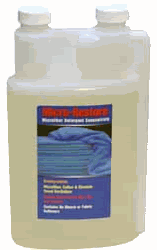Washing / Care Directions (micro fibre towels)
Heat acts as a catalyst promoting quicker reactions between chemicals and the soil thereby minimizing dwell time. Warm or hot water helps dissolve grease and oil in soil, agitation or hand rubbing helps pull the soil free. This concentrated aqueous formula is a special blend of surfactants, emulsifiers, chelating agents and water softeners.
Pre-Soak Micro Fibre Towels
Micro fibre towels can "load-up" with residues reducing their effectiveness. Don't let polish residues dry in the fibres as dried hardened product can cause scratches and product chemicals can negatively affect the fibres
Washing and Care
Once you have finished detailing with the towel, allow it to soak in a bucket with approx 0.5 oz per gallon water and a d-limonene (citrus) based cleaner P21S Total Auto Wash. Or use Optimum Power Clean? diluted 2:1 (or stronger) with distilled water) or a micro fibre detergent (Micro-Restore). This will make it easier to clean and prolong the life of the towel as any chemicals that could potentially harm the fibres are removed sooner, keep in mind that excessive use of powerful degreasers may eventually damage the fabric.
When you are ready to clean them, rinse well, re-wash and leave to air-dry
? Wash / Rinse after using and before you use a different product (i.e. don?t use to remove polish and then apply wax) to avoid cross contamination
? Always wash towels separately from other fabrics using hot water, the primary consideration is detergent residue so always use a detergent that is clean-rinsing
? Wash drying towels separate from wax/polish towels
? Washing your towels on a regular basis without allowing them get too soiled, they will last much longer
? Some detergents contain enzymes, which don't work well in cold water.
? Woolite? is intended for delicate fabrics and fine washables such as lingerie and cashmere sweaters, so it won?t remove polish or car care products
? As a pre-spotter: dilute 1 part concentrates with 3 parts hot water, apply to stain and launder as usual.
? Waxes and polymer sealants are not water soluble; they dry and adhere to the towels fibres. Cold water will simply allow them to remain in a solid state and not completely wash off.
? Hot water, however, allows them to soften and loosen from the threads and allows the detergent to act as it should and lift the contaminants from the fabric. Use hot (120oF) water and add 1-2 ounces to a standard size (8 gallon) load, for larger loads or heavily soiled laundry
? Use a liquid detergent (or a speciality product like Micro-Restore) without softener, bleach, whiteners.
? If possible buy the versions that are perfume and additive free as all these do is chemically coat the fabric and reduce its efficiency.
? Using half the washing detergents manufacturers suggested amount is usually sufficient
? During the rinse cycle add 1-tsb per towel white distilled vinegar to help dissolve detergent and hard water minerals
? Do not use fabric softeners or toss-in sheets, as they deposit chemicals (silicone, etc) on the fabric and render them ineffective. These chemicals will also transfer to whatever you are cleaning or polishing with the towel.
? Clean the lint screen before and after every wash session
Debris Caught in Fibres
Micro fibre towels are designed to hold onto various types of contaminants that can scratch a prized car; they need to be inspected after each washing, especially if there is any chance they might have been dropped or picked up some tree particles from the car. Even if your towels have never been dropped, if you wash them with towels that have, debris is potentially inside the washing machine drum
Notes:
1.
Lint or fibre shedding ? a dryer ball (Life Miracle? Dryer System?) seem to help as they fluff up the fibres and lessen the static that is the main cause of Microfibers trapping lint. Lint may also be trapped in the machine?s lint screen and its being transferred o the towel.
2.
For problematic wax only towels - try using very cold water to make the solidified wax brittle, then wash with hot again.
3.
Washing Machine - car products can get left behind in the drum. Run a cleaning cycle before and another once you?ve finished washing your micro fibre towels, using hot water, some liquid detergent and distilled white vinegar.
4.
Mixing Fabrics - Do not wash micro fibre cloths / towels with other non- micro fibre fabrics, as they will pick up lint from other fabrics. Air dry or you can dry micro fibre cloths / towels in any dryer on low heat, remove them before they are still damp (cuts down on static charge) Colours may bleed during first washing
5.
Drying ?air dry or use low / medium heat in a tumble dryer, adding two ?Dryer Ball? will help plump up the fibres?, the melting point of nylon 493. oF (256 ?C)so hot drying will not harm fibres
6.
Static ? to avoid static build-up remove towels from machine while they are still a little damp and air-dry
An extract from ?Micro fibre (Microfiber) Towels?, one of a series of 118 unbiased ?The Science of Detailing? technical papers, a library of educational materials that has become the #1 reference for car care on the Internet
Chances are you'll learn something about detailing if you read any of these; although these articles will not improve your detailing skills, lead to a successful business or change your life. Applying what you learn from it, however, will. That's where your commitment comes in - you need to make a commitment to yourself right now that you will take action on what you learn.
TOGWT ? Ltd (Established 1980) ? Copyright 2002-2010, all rights reserved


